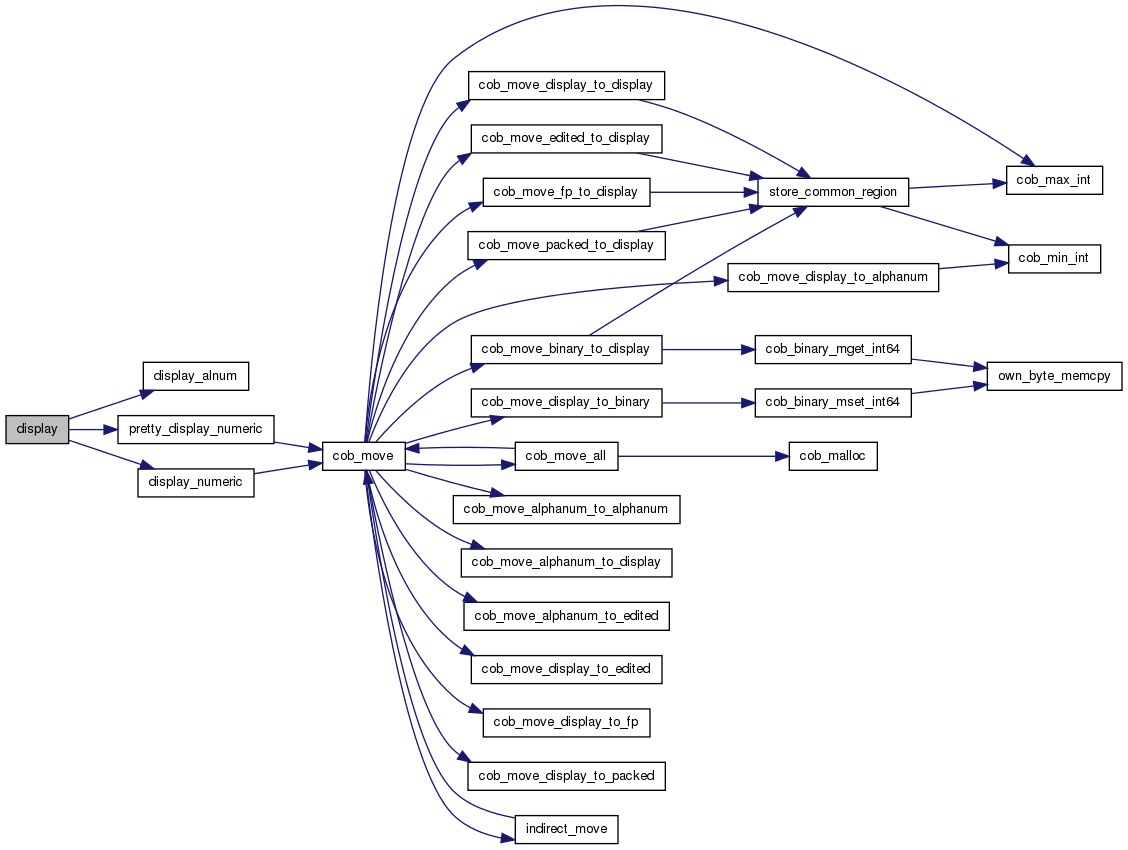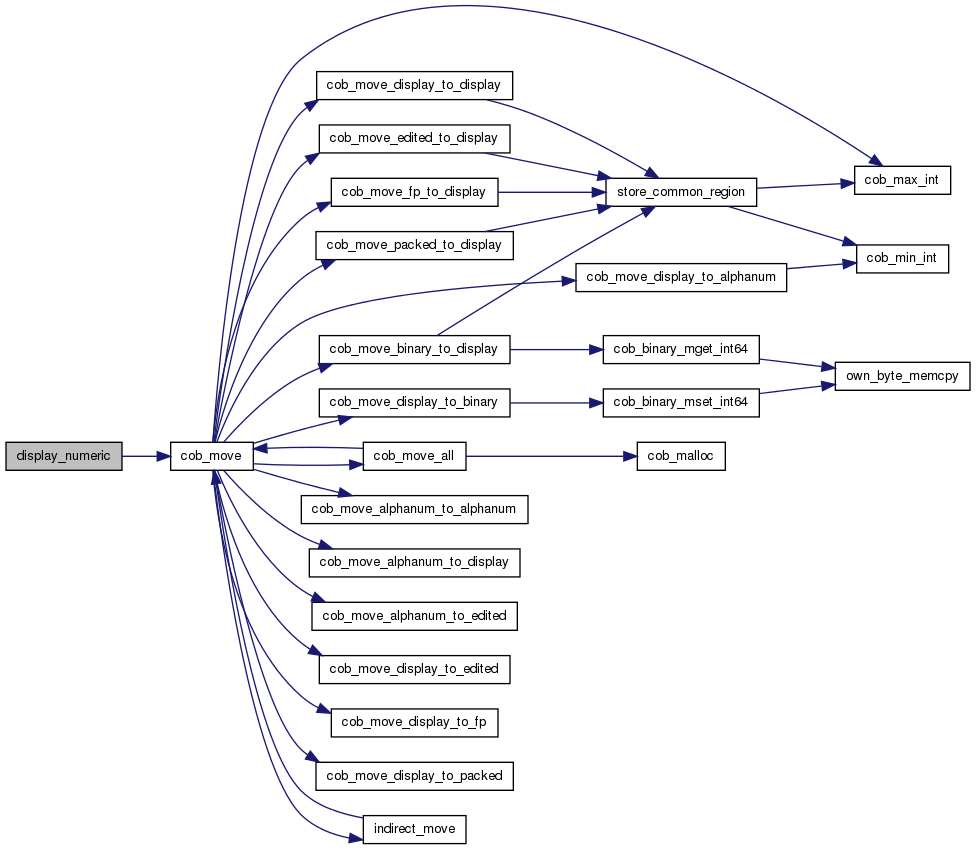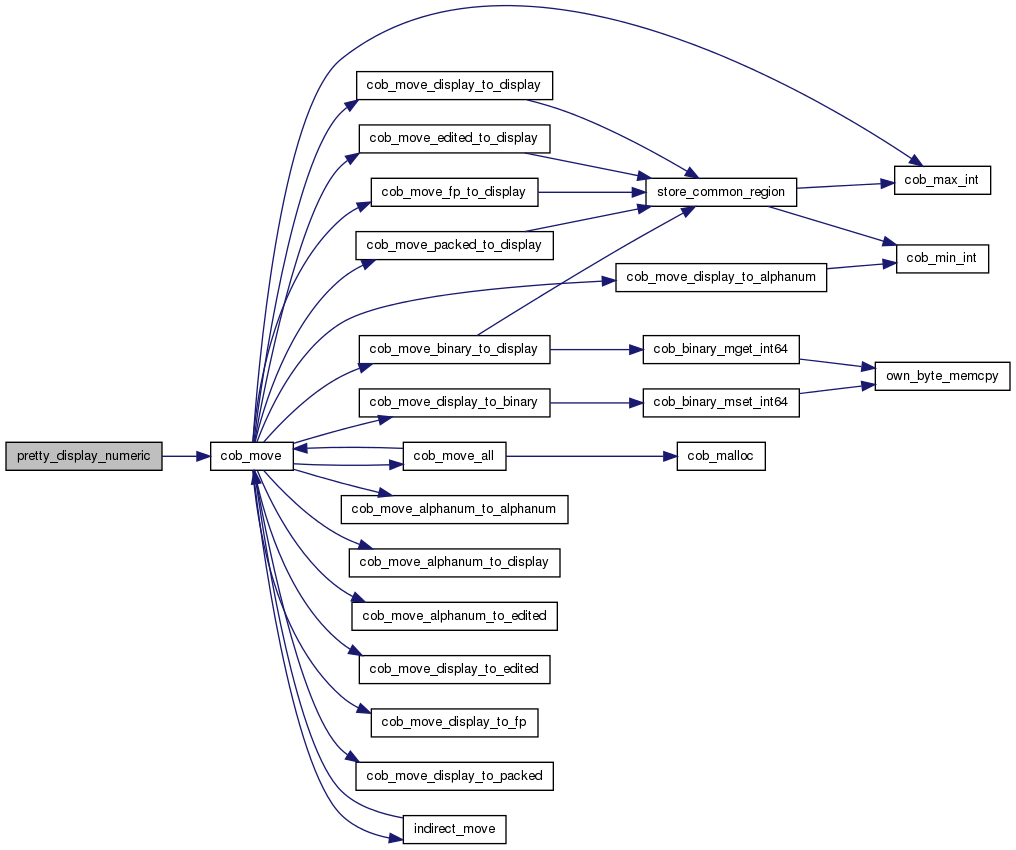|
OpenCOBOL 1.1pre-rel
|
|
OpenCOBOL 1.1pre-rel
|
#include "config.h"#include <stdio.h>#include <string.h>#include <stdlib.h>#include <stdarg.h>#include <unistd.h>#include <time.h>#include "move.h"#include "coblocal.h"#include "termio.h"#include "screenio.h"
Go to the source code of this file.
Functions | |
| static void | display_numeric (cob_field *f, FILE *fp) |
| static void | pretty_display_numeric (cob_field *f, FILE *fp) |
| static void | display_alnum (cob_field *f, FILE *fp) |
| static void | display (cob_field *f, FILE *fp) |
| void | cob_display (const int outorerr, const int newline, const int varcnt,...) |
| void | cob_accept (cob_field *f) |
| void | cob_init_termio (void) |
Variables | |
| static unsigned char * | term_buff |
| static const int | bin_digits [] = { 1, 3, 5, 8, 10, 13, 15, 17, 20 } |
| void cob_accept | ( | cob_field * | f | ) |
Definition at line 234 of file termio.c.
{
/* RXW
size_t size;
*/
cob_field_attr attr;
cob_field temp;
if (cob_screen_initialized) {
cob_field_accept (f, NULL, NULL, NULL, NULL, NULL, 0);
return;
}
temp.data = term_buff;
temp.attr = &attr;
COB_ATTR_INIT (COB_TYPE_ALPHANUMERIC, 0, 0, 0, NULL);
/* read a line */
if (fgets ((char *)term_buff, COB_MEDIUM_BUFF, stdin) == NULL) {
temp.size = 1;
term_buff[0] = ' ';
term_buff[1] = 0;
} else {
temp.size = strlen ((char *)term_buff) - 1;
}
if (COB_FIELD_TYPE(f) == COB_TYPE_NUMERIC_DISPLAY) {
if (temp.size > f->size) {
temp.size = f->size;
}
}
cob_move (&temp, f);
/* RXW
if (isatty (fileno (stdin))) {
temp.size = strlen ((char *)term_buff) - 1;
cob_move (&temp, f);
} else {
size = strlen ((char *)term_buff) - 1;
if (size > f->size) {
size = f->size;
}
memcpy (f->data, term_buff, size);
memset (f->data + size, ' ', f->size - size);
}
*/
}


| void cob_display | ( | const int | outorerr, |
| const int | newline, | ||
| const int | varcnt, | ||
| ... | |||
| ) |
Definition at line 205 of file termio.c.
{
FILE *fp;
cob_field *f;
int i;
va_list args;
if (!outorerr && !cob_screen_initialized) {
fp = stdout;
} else {
fp = stderr;
}
va_start (args, varcnt);
for (i = 0; i < varcnt; ++i) {
f = va_arg (args, cob_field *);
display (f, fp);
}
va_end (args);
if (newline) {
putc ('\n', fp);
fflush (fp);
}
}


| void cob_init_termio | ( | void | ) |
Definition at line 279 of file termio.c.
{
term_buff = cob_malloc (COB_MEDIUM_BUFF);
}

| static void display | ( | cob_field * | f, |
| FILE * | fp | ||
| ) | [static] |
Definition at line 157 of file termio.c.
{
unsigned char *p;
int n;
cob_field temp;
cob_field_attr attr;
if (COB_FIELD_TYPE (f) == COB_TYPE_NUMERIC_DOUBLE) {
double f1doub;
memcpy ((char *)&f1doub, f->data, sizeof (double));
fprintf (fp, "%-.18lf", f1doub);
} else if (COB_FIELD_TYPE (f) == COB_TYPE_NUMERIC_FLOAT) {
float f1float;
memcpy ((char *)&f1float, f->data, sizeof (float));
fprintf (fp, "%-.18lf", (double)f1float);
} else if (COB_FIELD_IS_POINTER (f)) {
fprintf (fp, "0x");
#ifdef WORDS_BIGENDIAN
p = f->data;
for (n = 0; n < sizeof(void *); ++n, ++p) {
#else
p = f->data + sizeof(void *) - 1;
for (n = sizeof(void *) - 1; n >= 0; --n, --p) {
#endif
fprintf (fp, "%x%x", *p >> 4, *p & 0xF);
}
} else if (COB_FIELD_REAL_BINARY(f) ||
(COB_FIELD_TYPE(f) == COB_TYPE_NUMERIC_BINARY
&& !cob_current_module->flag_pretty_display)) {
attr = *f->attr;
temp = *f;
attr.digits = bin_digits[f->size];
temp.attr = &attr;
display_numeric (&temp, fp);
} else if (COB_FIELD_IS_NUMERIC (f)) {
if (cob_current_module->flag_pretty_display) {
pretty_display_numeric (f, fp);
} else {
display_numeric (f, fp);
}
} else {
display_alnum (f, fp);
}
}


| static void display_alnum | ( | cob_field * | f, |
| FILE * | fp | ||
| ) | [static] |
| static void display_numeric | ( | cob_field * | f, |
| FILE * | fp | ||
| ) | [static] |
Definition at line 45 of file termio.c.
{
int i;
int digits;
int scale;
int size;
cob_field_attr attr;
cob_field temp;
unsigned char data[128];
if (f->size == 0) {
return;
}
digits = COB_FIELD_DIGITS (f);
scale = COB_FIELD_SCALE (f);
size = digits + (COB_FIELD_HAVE_SIGN (f) ? 1 : 0);
COB_ATTR_INIT (COB_TYPE_NUMERIC_DISPLAY, digits, scale, 0, NULL);
temp.size = size;
temp.data = data;
temp.attr = &attr;
if (COB_FIELD_HAVE_SIGN (f)) {
attr.flags = COB_FLAG_HAVE_SIGN | COB_FLAG_SIGN_SEPARATE;
if (COB_FIELD_SIGN_LEADING (f)
|| COB_FIELD_TYPE (f) == COB_TYPE_NUMERIC_BINARY) {
attr.flags |= COB_FLAG_SIGN_LEADING;
}
}
cob_move (f, &temp);
for (i = 0; i < size; ++i) {
putc (data[i], fp);
}
}


| static void pretty_display_numeric | ( | cob_field * | f, |
| FILE * | fp | ||
| ) | [static] |
Definition at line 80 of file termio.c.
{
unsigned char *p;
int i;
int digits;
int scale;
int size;
cob_field_attr attr;
cob_field temp;
unsigned char pic[64];
unsigned char data[256];
if (f->size == 0) {
return;
}
/* RXW
if (COB_FIELD_TYPE(f) == COB_TYPE_NUMERIC_BINARY) {
digits = bin_digits[f->size];
} else {
*/
digits = COB_FIELD_DIGITS (f);
/* RXW
}
*/
scale = COB_FIELD_SCALE (f);
size = (digits + (COB_FIELD_HAVE_SIGN (f) ? 1 : 0)
+ (scale > 0 ? 1 : 0));
p = pic;
temp.size = size;
temp.data = data;
temp.attr = &attr;
COB_ATTR_INIT (COB_TYPE_NUMERIC_EDITED, digits, scale, 0, (char *)pic);
memset (pic, 0, sizeof (pic));
memset (data, 0, sizeof (data));
if (COB_FIELD_HAVE_SIGN (f)) {
*p++ = '+';
i = 1;
memcpy (p, (unsigned char *)&i, sizeof(int));
p += sizeof(int);
}
if (scale > 0) {
*p++ = '9';
i = digits - scale;
memcpy (p, (unsigned char *)&i, sizeof(int));
p += sizeof(int);
*p++ = cob_current_module->decimal_point;
i = 1;
memcpy (p, (unsigned char *)&i, sizeof(int));
p += sizeof(int);
*p++ = '9';
i = scale;
memcpy (p, (unsigned char *)&i, sizeof(int));
p += sizeof(int);
} else {
*p++ = '9';
i = digits;
memcpy (p, (unsigned char *)&i, sizeof(int));
p += sizeof(int);
}
cob_move (f, &temp);
for (i = 0; i < size; ++i) {
putc (data[i], fp);
}
}


const int bin_digits[] = { 1, 3, 5, 8, 10, 13, 15, 17, 20 } [static] |
 1.7.4
1.7.4